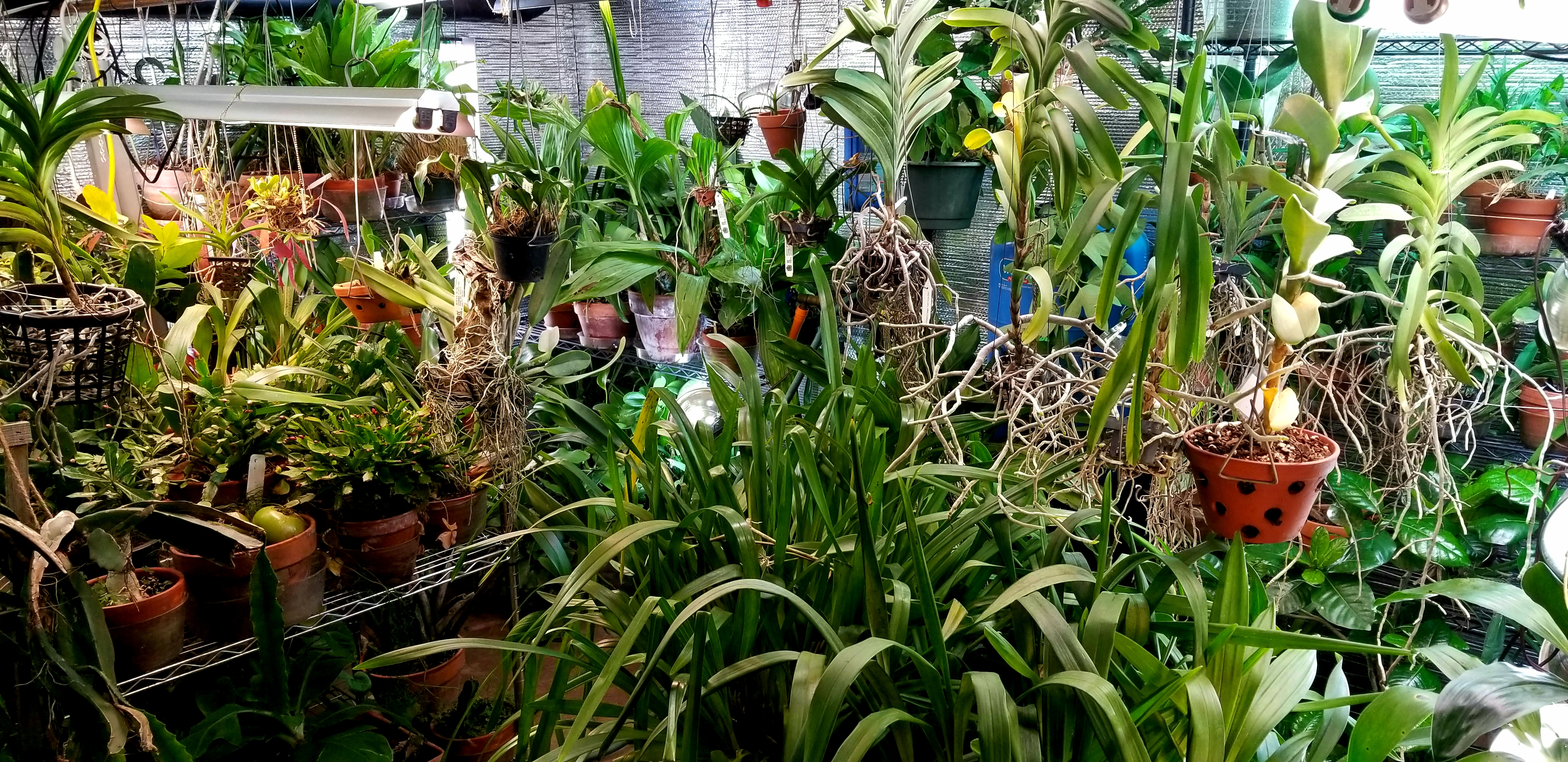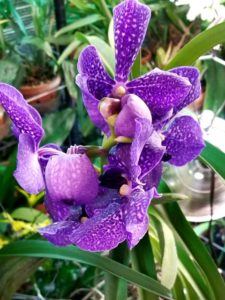
Managing Orchids Which Spend Summers Outdoors and Winters Under Lights
If you live in a place where most epiphytic or lithophytic orchids are not supposed to grow, and you grow them anyhow, and you bring them out for the sunshine, humidity, and regular rainfall each summer; then you know the pain when it’s time for them to escape killing frosts, and go back under lights. In the north that is just 4-5 months in the kind of environment they prefer to grow.
Root tips expand, new pseudobulbs emerge, leaves expand, and new flower stalks surprise us. They get the right mix of sun and shade, rapid leaf-drying and timely downpours. Another great benefit of being outdoors is that predator insects living in the natural environment tend to keep the worst pest offenders under control. So even if you had to fight pests all winter, indoors, their damage tends to diminish once the plants are brought outside.

Orchids set-up on backyard deck
Diseases of newly emerging leaves exposed to more frequent leaf-wetting outdoors can pose a more immediate threat outside, because softer tissue is more susceptible to several diseases. Assuming you come out of the summer without much insect or disease damage, you face a new set of challenges when you bring them back inside (even if you are fortunate enough to own a greenhouse).
They typically experience less effective lighting, either due to the diminished angle of the sun, less ideal wavelength lighting, or because the length of daylight is hard to copy. This causes weaker plants, poorer leaf and pseudobulb elongation, and concurrently, root elongation often stops. This is evident when the new growing tip, typically free of velamen, is no longer pushing out green to maroon new growth, and the white velamen reaches the tip of the roots.

Healthy Vanda Orchids
Additionally, while diseases are less common as winter problems, insects, no longer under the control that predator insects provide, can explode with unchecked reproduction. Consistently higher indoor temperatures also accelerate their population growth. Another less obvious problem occurs when you attempt to control pests with products you might have used outside, only to realize that their odors are intolerable indoors, and at times, worrisome.
Thankfully, there are solutions to many of these problems, and eventually, those who are successful with this orchid obsession learn to anticipate what can occur. There are typically two types of insects that I have found most problematic. Aphids are soft bodied and suck the sap from newly grown plant parts. They require attention before their populations explode but are generally easy to control once detected. Mealy bugs are a bigger concern, a larger insect, covered in white material that sheds water and anything you spray, often requires an oil-based product to cut through their waxy coating to allow the insect control to reach them. The worst of the winter pests for orchids is the Boisduval scale, and their favorite orchid species are the Cattleya family. They can be found in leaf axils, under leaves, on pseudobulbs, or pretty much all plant components.
Photo: Boisduval Scale

For soft bodied insects there are several products you might consider. Eco-1 is a broad-spectrum botanical oil based, organic solution. It has a mint like odor and is diluted with water. It also has powdery and downy mildew disease fighting properties as well. Additionally, another organic OMRI certified product called AzaSol derived from the Neem tree has multiple protective properties. It kills feeding insects, discourages egg laying, and discourages feeding. It can disrupt insect life cycles to prevent them from reproducing. For the Boisduval Scale, I know of only one effective insect control, called Distance, a growth regulator, used in very low doses, will control it. Compared to both AzaSol and Eco-1, it is significantly pricier, but this scale will eventually kill your Cattleya species if ignore
Two other issues that must be addressed for indoor orchids is when to fertilize and water. Generally, if growing in porous media, plants will need regular watering. Many orchids tolerate a natural dry period during the winter, so watering may be cut back, but if pseudobulbs begin to wrinkle, you may not be giving them enough water. Check online for the species you grow. While fertilizer frequency may often be reduced, in general, a dilute amount should be applied every 2-3 weeks while indoors, followed by a good drenching with water during the next watering cycle. Again, review cultural requirements for your species.
If you’ve maintained them well throughout the long northern winters, you will once again be able to treat them to the conditions necessary for true plant growth, a multi-month vacation in the outdoors. Remember when you bring them out to give them mixed sun and shade for a few weeks while they reacclimate to direct sunshine, or you can experience burned foliage that remains visible for years.
Happy Gardening,
&
Rob Gorden
Arborjet‘s Director of Urban Forestry and Urban Development


Sorry, the comment form is closed at this time.